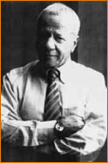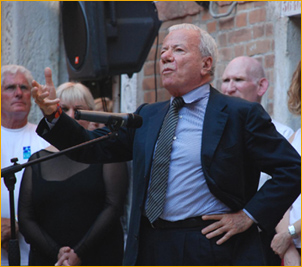 Art
and Photography > What Others Say About Adi Da's
Art > Achille Bonito Oliva
Art
and Photography > What Others Say About Adi Da's
Art > Achille Bonito Oliva
Commentary at the Inauguration of
the Exhibition of Adi Da's Art
at the
52nd Biennale di Venezie
by Achille Bonito Oliva
June
9, 2007

 Achille
Bonito Oliva is an international acclaimed art critic and historian, and a
teacher at La Sapienza University in Rome. He has acurated numerous thematic and
interdisciplinary exhibitions in Italy and abroad. Bonito Oliva was the Director
of the 39th and 45th Venice Biennale. He has been awarded various prizes and recognitions,
including the Valentino d’Oro, an international prize for art critics. He has
authored and edited many essays and books on art, including Alighiero
Boetti: Delivering Art to the World, Art
Tribes, White
and Other: In Any Case, Art, and Luca
Pignatelli.
Achille
Bonito Oliva is an international acclaimed art critic and historian, and a
teacher at La Sapienza University in Rome. He has acurated numerous thematic and
interdisciplinary exhibitions in Italy and abroad. Bonito Oliva was the Director
of the 39th and 45th Venice Biennale. He has been awarded various prizes and recognitions,
including the Valentino d’Oro, an international prize for art critics. He has
authored and edited many essays and books on art, including Alighiero
Boetti: Delivering Art to the World, Art
Tribes, White
and Other: In Any Case, Art, and Luca
Pignatelli.
Oliva delivered the following remarks
at the opening of Adi Da's Art Exhibition at the Venice Biennale in 2007.

When
I first saw the images of Adi Da Samraj, I found myself in front of work that
was not an artifice (or the simply technical production of a language), but that,
rather, was the fruit of a creative experience aimed at enabling a new perception
of reality in the viewer.
We are used to considering twentieth-century
art in terms of groups of artists, schools of thought — on the one hand
objectivity, on the other hand subjectivity; on the one hand the artist who expresses
himself through impersonal, neutral forms, on the other hand the artist who instead
wants to document and express his own identity.
Looking at Adi
Da’s works, I had a strange sensation of serenity. I was confronted with works
that left me not without words but without thought, so that I couldn’t exercise
my consummate technique as an international art critic! I believe that art should
always be a surprise. It must create, even in the critic, not emotion, but a sense
of insecurity. When one views Adi Da’s art, it’s easy to see “pop art”, “optical
art”, all the possible linguistic, ethnological, and iconographic references —
but, in the end, the final work is always a surprise.
With Adi
Da’s work, I didn’t simply find myself in front of a new personal iconographic
universe but rather in front of images that returned me to an experience of “epiphany”.
Adi Da’s image-work constitutes an epiphany in the sense that it presents itself
neither in objective nor in subjective terms. It doesn’t belong either to the
universe of the artistic search of the 20th century, the whole canon of optical-perceptual
experimentation that was developed in the 1950s and 60s, nor on the other hand
to an expressionist creation that tends to represent identity and subjectivity.
The image in Adi Da’s work is, rather, a synthesis of matter
and energy, of abstract and figurative. It is an attempt to bring to the viewer
the perception of its creative process. Within each image, every element develops
the transition to the successive one. So there is an expression of fertility,
of proliferation, of vitality. It is an energy, a breath that irradiates and pervades
the iconography of the artwork.
It is interesting to see Adi
Da’s work as a reality confronting the viewer — visually, physically, mentally,
and spiritually. It is a work that attempts to communicate reality both as matter
and as spirituality. Leonardo Da Vinci said: “Painting is a mental thing.” Adi
Da uses photographic and digital means, but in terms of representation. The monumental
works in the exhibition are a path of experience, of contemplative nomadism, for
the viewer.
Western metaphysics is always linked to myth and
culture — Ulysses, Greek culture, the myth of the Latin, Greek, and pagan
deities — whereas the metaphysics created by Adi Da paradoxically communicates
spirituality in a language similar to pop art, which is a "consumer" language.
But Adi Da’s work is absolutely not "consumeristic". It is work in which the viewer
descends into reality. This language of reality is not a superficial language
— rather it could be said it is a language that, through its surface, acquires
its depth.
Details are very important in Adi Da’s work. The
work cannot be taken in with just one look, like a flash. Every work needs to
be experienced, to be entered into, as a journey of the eyes. Adi Da’s work, through
epiphany, is purposed to connecting the viewer with reality.
Adi
Da depicts the state of things. But for “thing” I do not mean a static object
or an inert element, but “thing” as condition that no longer has any superstructures,
but rather connects to whoever contemplates it — the subject, the world,
humanity. So Adi Da’s Transcendental Realism is a form of neo-humanism that wants
to develop a relationship with art with a very vast public as a starting point.
The iconographic elements, whether abstract or figurative, are always recognizable.
Therefore, there is a sense of "visual democracy" — the possibility for
the viewer to find in front of himself an iconographic universe where Adi Da becomes,
one could say, the guru who extracts signs and images from the recognizable "alphabet"
of visual perception, in a system that is highly connecting.
Adi
Da’s artistic creation develops a testimony and a knowledge of this great experience.
There is the possibility, on the part of the viewer, to consider and to feel the
experience. The viewer is the protagonist of a relationship with the work, both
on the level of the physical experience and also absolutely on the psychic level.
I also feel that there is a sort of tactility in Adi Da’s work. If one watches
very carefully, there is a way of working that is analytical, in a microscopic
manner, and there are small parts that are without contours, that are embedded,
and there are levels of this visual surface that are also levels of emotional
depth.
Transcendental Realism means a profound reality, a real
depth, it means matter and spirituality and thus transcendence of the sensibility
of mere "spectacle". If someone asks me to describe one of Adi Da’s works, I cannot
do it. It is a labyrinth in which, once one enters, maybe it is better not to
exit. The work of Adi Da is a spiritual nourishment, and we are here to celebrate
it.
I wish everyone a wonderful journey into Adi Da’s creative
universe.
|
Achille
Bonito Oliva delivering the above commentary
on Adi Da's Art |



186,104 people have liked our site's pages and shared them with their Facebook friends - Most Shared Pages
© 2025 Copyrighted materials used with the permission of The Avataric Samrajya of Adidam Pty Ltd, as trustee for The Avataric Samrajya of Adidam. All rights reserved. None of these materials may be disseminated or otherwise used for any non-personal purpose without the prior agreement of the copyright owner. ADIDAM is a trademark of The Avataric Samrajya of Adidam Pty Ltd, as Trustee for the Avataric Samrajya of Adidam.
Technical problems with our site? Let our webmaster know.